|
|
|||||
| home > architetture | |||||
| BREATHING
DESIGN TEAM. Nam June Paik Museum, Korea |
|||||
| "In
the same way as the Japanese succeeded in creating haiku poems, video
artists must learn to express themselves in the space of thirty second
s ... otherwise we will not survive the next Century. My video sculptures
are more popular than my registrations. You need only ten seconds, twenty
at the most, for my sculptures, as for a picture. You can look at them
– look at them again – and then go away." Nam June Paik "Powerful interventions, presences and insertions – entering and exiting spaces - in a continual movement; inside and outside the visual image; subject and object, author and his work, all as one, together. I am thinking of "action" as an engine and an expression, as material and as a product. It is to Nam June Paik that we owe this new vision of the human being and the artist. A conception that comprises the idea of communication, interaction, fusion and flux. A nomad capable of travelling through streets and through stories, of reading past and present – of transforming and being transformed, of uniting technical talent and artistic invention. A knowledgeable man, a shaman, a master of scientific method, informatics and techniques, a traveller and audiovisual explorer of different worlds: this is Nam June Paik. Himself a medium, a bridge between communication and technology, between the agent and his interlocutor." Denis Curti |
|||||
| [in italiano] | Nam
June Paik is one of the first artists to recognize the potential of
the electronic medium and its influence on culture and on the economy. |
[02jan2004] | |||
 The project attempts to incarnate the poetry of this pioneer of video art, re-enacting in a contemporary key the subject covered by the artist in his work: the medium. What we understand as a "medium" building is one through which information can be diffused. The era of electronics and informatics assumes that "projection, mutation and simulation" are the three key inspirational words of a type of architecture which moves its message and forms more and more to the exterior, to areas of immediate and superficial impact; architecture, becoming more and more a screen, should be a neutral support for images which speak out for themselves loudly. If this occurs its message can "finally" compare itself with the world of fashion, publicity and television. |

|
||||
 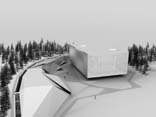 
|
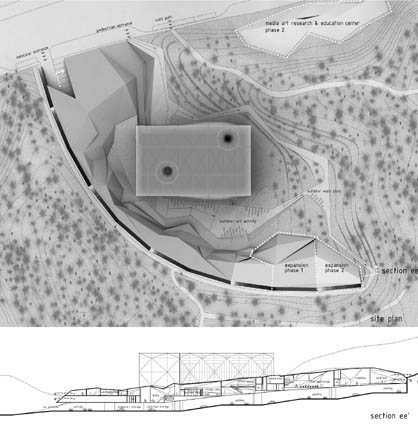 Site plan and section. An example could be the installations of Toyo Ito, nearer to visual art than to real architecture, therefore aesthetically autonomous and not aiming at a specific function. They succeed in expressing the contemporary aesthetic line of "cut and stick": putting together images from different sources in a casual and disenchanted collection free from complimentary quotes and quotations, dichotomy of originals/copies, etc. |
||||
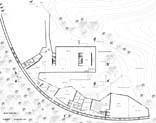 Ground floor plan. |
 Secon level. In a society that is satiated with ever more extreme and sophisticated forms of communication it is necessary to raise the "shock" level by using bigger dimensions and brighter colours to relate to publicity images. And the Museum offers itself exactly as a neutral support ready to receive infinite images, information and data. In particular the project is divided into two distinct parts: - The first, the focal point of the project, is a monolith which has landed on the site like a body that is alien to its context and it is thanks to this detachment, purposely emphasized, that it succeeds in respecting and not invading the scenery; it "floats" above as a temporary element ready to take off in flight from one moment to the next. This building houses the main exposition rooms. - The second is a low curved tongue which blends into the morphology of the existing valley following the contour lines. The character of this building, which is partly underground, is not completely mimetic; in fact it emerges from the ground as might emerge a rock from a wind eroded landscape. This building contains the car parks, the secondary and service functions. |
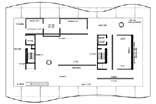 Exhibition area. |
|||
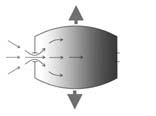 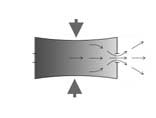 
|
  Precisely because of its character which is alien to the natural surroundings the "monolith" is composed of materials that are visibly artificial and uses technologies which are certainly more sophisticated and extreme than in the rest of the project. As it is an artificial lung – a perfect machine that carries out various functions (among which the circulation of air inside the building) it is a lightweight, changing mechanism. It is composed of a membrane connected to mobile pistons thanks to flexible telescopic bodies in fibreglass, lined on the inside of the skin so as to distribute the load uniformly on all the mobile walls. The membrane which completely enwraps the building is supported by pistons and by a steel grid structure which grips the rest of the building which rests on high capacity floors built on concrete pylons which contain the vertical elements such as the lifts and emergency stairs, miscellaneous fixtures and services. |

|
|||
 This monolith has the sensitivity and ambiguity of a chameleon; in fact, like a living being, thanks to "feelers" it has the capacity to see, hear, taste, smell and feel, and thanks to these "feelers" it can react to outside stimuli and vary its reaction to them. Its shape and the colour of its skin change, transmitting information to the outside world in the form of lights, sounds, words and movements. |

|
||||
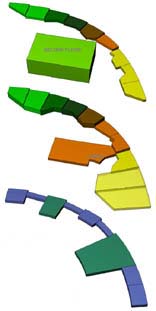 |
Technically
this is all possible thanks to a series of artificial aids/feelers such
as video cameras, microphones, photoelectric cells sensitive to light,
all capable of reacting to humidity, wind, smog, and which pass information
to a software dedicated to the overall coordination; the building will
thus react differently to daylight, darkness, wind, rain, traffic, number
of people present inside the building, noises etc. The most obvious mutations are: - The swelling of the external membrane, made possible by a series of pistons; - The change in colour made possible by internal projectors which, besides modifying the colour of the building, can transmit any kind of message, picture or video. The bio-climatic control of the building functions with the cyclical swelling of the membrane which like a lung, in moments of maximum expansion, opens valves in one of the two clefts on the membrane, lets the air enter, and in the moment of lesser volume, lets the air out of the second cleft. The technical testing of this system has been studied together with the aero-space engineer Giuliano Ranuzzi. We have made a preliminary study of the interaction of aerodynamic flux, calculating the fields of movement and of pressure and the strain on the building. 3gatti.com mail@3gatti.com |
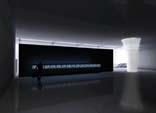 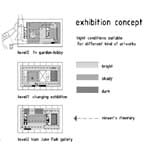
|
|||
| BREATHING
DESIGN TEAM. Nam June Paik Museum, Korea |
|||||

|
Progetto
sviluppato in occasione del Concorso
internazionale d'idee per il Nam June Paik Museum. project: Francesco Gatti Matteo Grimaldi (project manager) Veronica Didier (developer) Laura Grimaldi (developer) consultants: Massimo Cardone (architect) Stanislao Cantono di Ceva (designer) Sergio Paolantonio (interaction designer) Gabriele Chiaretti (designer) Grazia Didier (media designer) Giuliano Ranuzzi (aero-space engineer) |
||||
| > NAM JUNE PAIK MUSEUM COMPETITION | |||||
|
Per
candidare progetti laboratorio
|
|||||